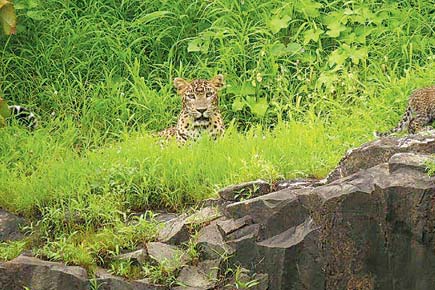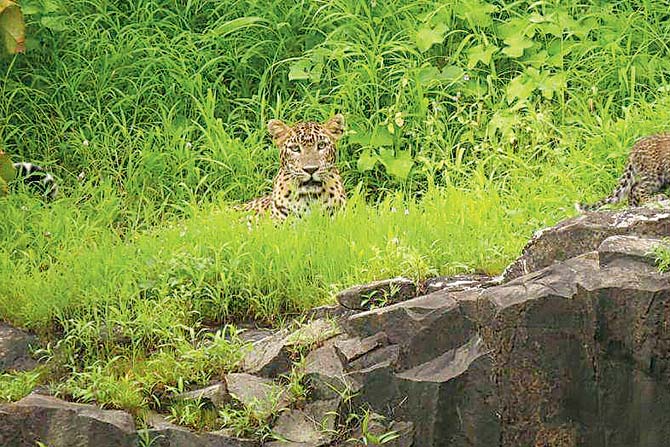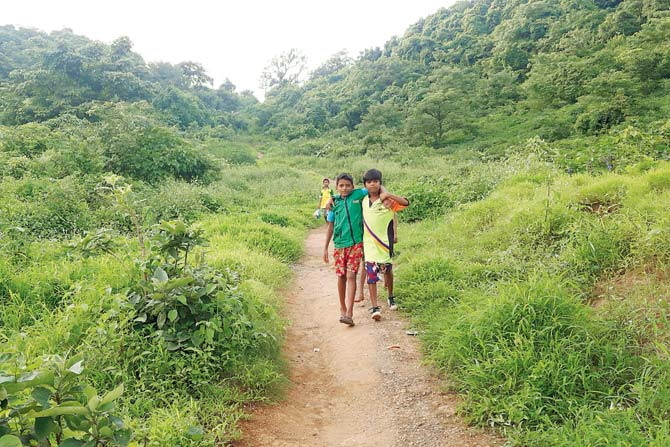Forest department has been constantly keeping mud trails clear of vegetation to prevent leopards from taking cover in it


Leopards hide in the tall grass at Aarey that grows during the monsoon, laying in wait for dogs, other small animals and children
ADVERTISEMENT
Aarey Milk Colony is proof that humans and animals can co-exist in harmony. No human-leopard conflict has been reported — despite the area having over five leopards — in nearly two years now.
Some 50,000 people, including 2,500-3,000 tribals from 27 hamlets, share space with the leopards. There are also some 20 slums that have encroached upon the land.
The credit for the peaceful co-existence goes to something as simple as trimming overgrown grass and foliage around the tribal hamlets. The absence of a thicket to serve as a hiding spot deters leopards — which are known to be shy animals — from venturing into human habitats in search of food.
 The grass cutters employed by the forest department to ensure that all overgrown vegetation is cut after the monsoon so that leopards cannot hide in it
The grass cutters employed by the forest department to ensure that all overgrown vegetation is cut after the monsoon so that leopards cannot hide in it
The Thane forest department took over the responsibility of trimming foliage after the municipal ward office and the Aarey CEO office allegedly ignored the pressing need to address the issue. The forest department now has dedicated ‘grass cutters’ at Aarey.
KP Singh, chief conservator of forests, Thane (territorial), says the department also joined hands with volunteers two years ago to monitor leopard activity via camera traps and conduct awareness programmes in tribal hamlets on avoiding conflicts. "We also make sure that foliage around the padas (hamlets) are cleared after the monsoon recedes. This year, work has already begun at Mataipada."
The constant vigilance and clean hamlets has also helped keep stray dogs away. Leopards often venture into human habitats in search of dogs, poultry and pigs.

Schoolchildren walk to school without fear after the grass is cut
Spurred by sightings
The trimming work has begun at Mataipada since a leopard was spotted in the hamlet recently. “We don’t want any untoward incident there. So, a week ago, we began trimming grass, as tall as 2-3 ft, with machinery on the mud trails and around houses. We also plan to launch an awareness programme and similar foliage trimming exercises in other padas,” said a senior forest department official.
Frequent leopard sightings have been reported from many padas in the last two to three weeks.
Complaints
Tribals in the padas are thankful for the forest department’s measures, but are angry with the Aarey CEO’s office, the BMC and elected representatives for failing to maintain the solar streetlights in their hamlets.
The Aarey forested area falls under the charge of the Aarey Milk Colony CEO’s office and the BMC, but since it is not a reserved forest, it also comes under the jurisdiction of the territorial range of the Thane forest department.
“Illegal slums have proper lights and paver blocks on footpaths, but we have to risk our lives by walking in the dark, as the majority of solar lights have gone defunct,” said Ankush Bhoir, a member of the tribal Warli community.
mid-day confirmed this claim during a visit to the spot. Some streetlights were even stolen.
Gajanan Raut, CEO of Aarey Milk Colony, however, claims that most streetlights are functional. “Some slum pockets are not kept clean, which attracts stray dogs and leopards.”
An official from the BMC ward office shifts blame on elected representatives. “They visit the tribal hamlets only during elections, and forget their promises after winning. Some solar lights have stopped functioning and some have been stolen, but the public representatives are bothered about addressing this. The public representatives should have appointed people to clear foliage around padas.”
27
No. of hamlets in Aarey
28
No. of leopards rescued in the last 12 years
 Subscribe today by clicking the link and stay updated with the latest news!" Click here!
Subscribe today by clicking the link and stay updated with the latest news!" Click here!






